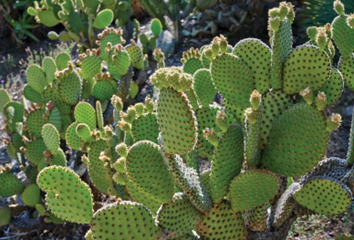Environment & Ecology
Context: Recently Union Minister of Rural Development and Panchayati Raj convened a consultation meeting on ‘Cactus Plantation and its Economic Usage’.
- Various options for taking up Cactus plantation on degraded land should be explored for realising the benefits of its usage for bio-fuel, food and bio-fertiliser were discussed in the meeting.
- India has approximately 30% of its geographical area under the category of degraded land.
About Cactus:

- A cactus is a member of the plant family Cactaceae.
- Although some species live in quite humid environments, most cacti live in habitats subject to at least some drought.
- Many live in extremely dry environments, even being found in the Atacama Desert, one of the driest places on Earth.
- Because of this, cacti show many adaptations to conserve water.
- For example, almost all cacti are succulents, meaning they have thickened, fleshy parts adapted to store water.
- Unlike many other succulents, the stem is the only part of most cacti where this vital process takes place.
- Most species of cacti have only spines, which are highly modified leaves.
- Spines help prevent water loss by reducing air flow close to the cactus and providing some shade.
- In the absence of true leaves, cacti’s enlarged stems carry out photosynthesis.
Conservation:
- All cacti are included in Appendix II of the Convention on International Trade in Endangered Species of Wild Fauna and Flora (CITES).
- Control is exercised by making international trade in most specimens of cacti illegal unless permits have been issued, at least for exports.
- Some cacti, such as all Ariocarpus and Discocactus species, are included in the more restrictive Appendix I.
Uses:
- Cactuses are known for their nutrients as well as their medicinal value.
- Both cactus pads and cactus fruit can help fight infections and ease the symptoms of anything from hangovers to high cholesterol.
- Both the cactus pad and the cactus fruit are high in fiber, which can lower cholesterol levels in the blood.
- used as ornamental plants
- used for fodder or forage,
- Cactus fruits in particular are an excellent source of vitamin C, which is one of the best immune boosters.
- Regular doses of vitamin C increase the production of white blood cells, which can make us less likely to catch an illness — and help your body fight off viruses if infected.
- Nutrition: Cactus fruits and pads offer a dose of vitamins and nutrients that have anti-inflammatory properties and can help reduce the risk of serious health conditions like diabetes and heart disease.
Source: PIB
Previous Year Question
Q.1) With reference to “Gucchi” sometimes mentioned in the news, consider the following statements:
- It is a fungus.
- It grows in some Himalayan forest areas.
- It is commercially cultivated in the Himalayan foothills of north-eastern India.
Which of the statements given above is/are correct?
- 1 only
- 3 only
- 1 and 2
- 2 and 3
Q,2) If a particular plant species is placed under Schedule VI of The Wildlife Protection Act,1972, what is the implication? (2020)
- A licence is required to cultivate that plant
- Such a plant cannot be cultivated under any circumstances
- It is a Genetically Modified crop plant
- Such a plant is invasive and harmful to the ecosystem














